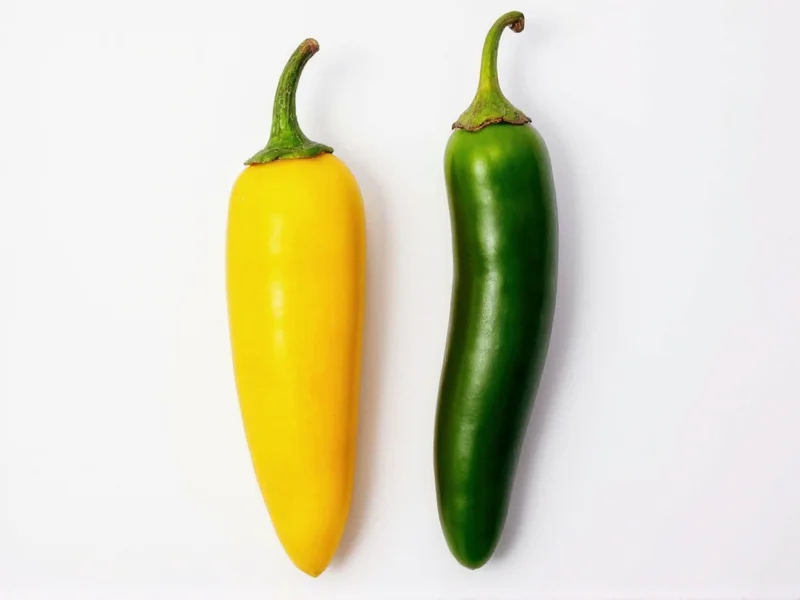Understanding the precise heat levels between jalapeño and serrano peppers is essential for home cooks and professional chefs alike. These two popular chili peppers often appear in similar recipes but deliver dramatically different heat experiences. The Scoville scale provides the scientific measurement needed to make informed decisions when selecting peppers for your dishes.
Scoville Scale Comparison: Quantifying the Heat Difference
The Scoville scale measures capsaicin concentration, the compound responsible for chili pepper heat. While both peppers belong to the Capsicum annuum species, their heat profiles differ substantially:
| Pepper Type | Scoville Heat Units (SHU) | Relative Heat Level | Heat Comparison Reference |
|---|---|---|---|
| Jalapeño | 2,500-8,000 SHU | Moderate | 2-5x milder than serrano |
| Serrano | 10,000-23,000 SHU | Hot | 2-9x hotter than jalapeño |
| Tabasco Sauce | 2,500-5,000 SHU | Moderate | Similar to mild jalapeños |
| Cayenne Pepper | 30,000-50,000 SHU | Hot | Hotter than serrano |
Flavor Profiles Beyond Heat
While heat measurement is crucial, flavor complexity separates these peppers in culinary applications. Jalapeños offer a grassy, bright flavor with subtle fruitiness that many find approachable. Their thicker walls make them ideal for stuffing, pickling, or roasting. Serranos deliver a sharper, more intense heat with a brighter, almost citrusy note and thinner walls that integrate more readily into salsas and sauces.
Food scientists note that serranos contain higher concentrations of volatile compounds that contribute to their distinctive aroma. This makes serranos particularly effective in raw applications where their flavor can shine without cooking modification, while jalapeños often benefit from roasting or smoking to develop their flavor profile.
Physical Characteristics and Identification
Visual identification helps prevent accidental heat overload in your cooking. Jalapeños typically grow 2-3.5 inches long with smooth, thick skin that transitions from bright green to deep red as they mature. They grow pointing downward on the plant. Serranos are smaller (1-2.5 inches), with a distinctive tapered shape, thinner skin, and grow upright on the plant. Their color progression moves from bright green through yellow and orange to red.
When selecting peppers at the market, look for firm, unblemished specimens. For jalapeños, darker green varieties tend to be milder, while those with 'corking' (light brown striations) often indicate more mature, potentially hotter peppers. Serranos maintain consistent heat throughout their color spectrum, though red varieties may offer slightly more developed flavor.
Culinary Applications and Substitution Guidelines
Understanding the jalapeño vs serrano Scoville difference directly impacts recipe success. For authentic Mexican salsas verdes, serranos provide the traditional sharp heat that defines the dish. When making poppers or stuffed peppers, jalapeños' thicker walls and milder heat create a more balanced eating experience.
If substituting between these peppers, consider these evidence-based guidelines:
- Replace 1 jalapeño with ½ to ⅔ serrano for equivalent heat
- Remove serrano seeds and membranes to reduce heat by up to 80%
- For raw applications, use serranos sparingly as heat perception intensifies when uncooked
- When cooking for extended periods, add serranos later than jalapeños to preserve flavor integrity
Growing Considerations for Home Gardeners
Gardeners should note that environmental factors significantly impact actual heat levels. Both peppers produce hotter fruit when stressed by limited water or nutrient availability. Serranos typically mature faster (60-80 days) compared to jalapeños (70-90 days), making them suitable for shorter growing seasons.
Soil pH between 6.0-7.0 optimizes growth for both varieties, though serranos demonstrate slightly better tolerance to acidic conditions. For container gardening, choose compact varieties like 'Habanero' serranos or 'Early Jalapeño' for best results in limited spaces.
Safety and Handling Best Practices
Working with hotter serranos requires additional precautions. Always wear gloves when handling serranos, especially when removing seeds and membranes where capsaicin concentration peaks. Never touch your face during preparation, and wash all surfaces thoroughly after use.
If you experience skin irritation, apply milk or yogurt to affected areas rather than water, which spreads capsaicin. For accidental eye contact, seek medical attention immediately as capsaicin can cause significant discomfort lasting several hours.
Conclusion: Making the Right Pepper Choice
The jalapeño vs serrano Scoville comparison reveals more than just numerical heat differences—it highlights how these peppers serve distinct culinary purposes. When crafting authentic Mexican cuisine, understanding these differences ensures proper heat balance and flavor development. For everyday cooking, knowing that serranos deliver 2-9 times more heat than jalapeños helps prevent recipe disasters while expanding your flavor possibilities.











 浙公网安备
33010002000092号
浙公网安备
33010002000092号 浙B2-20120091-4
浙B2-20120091-4